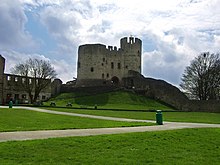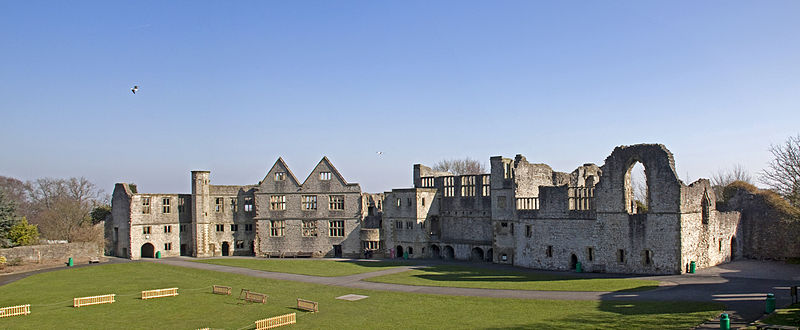Dudley Castle
Dudley Castle is a ruined castle in the town of Dudley in the English administrative division of West Midlands . The Zoo of Dudley is also located on the castle grounds. The site, Castle Hill , is an outcrop of limestone the Wenlock group to which during the industrial revolution have been established on a large scale quarries. Along with Wren's Nest , it is considered to be one of the best-preserved limestone industry sites in Dudley and the Scheduled Monument . Dudley Castle has been listed as a Grade I Historic Building by English Heritage . The Dudley Tunnel runs under Castle Hill, but not under the castle ruins themselves.
history
According to a legend, an Anglo-Saxon nobleman named Dud was said to have had a wooden castle built here in the 8th century. However, this legend is not taken seriously by historians; they date the construction of the first castle there to the time immediately after the Norman conquest of England in 1066 . It is believed that one of William the Conqueror's followers , Ansculf de Picquingny , built the first castle at Dudley in 1070 and that it belonged to his son, William FitzAnsculf , when the Domesday Book was written in 1086 . Some of the earthworks of this castle, especially the great Mound der Motte , on which the donjon now stands, have been preserved to this day. This first castle was made of wood and therefore no longer exists.
After FitzAnsculf's death, the castle fell to the Paganel family , who had the first stone castle built on the site. This castle was strong enough to withstand the siege of King Stephen's troops in 1153 . After Gervase Paganel had joined an unsuccessful rebellion against King Henry II in 1173 , the castle was destroyed at the king's behest. The Somerys were then the next dynasty to own the property; they began building another stone castle in the second half of the 13th century and continued into the 14th century. The donjon, which today is the eye-catcher of the castle from the city, and the main gate date from this period of reconstruction. A chapel and a knight's hall were also built at that time.
The last male scion of the Somery family, John Somery , died in 1321 and the castle and estate fell to his sister Margaret and her husband John de Sutton . As a result, members of this family often used the name "Dudley". In 1532, another John Sutton (the seventh of that name in the dynasty) inherited the castle, but was ousted in 1537 by his relative John Dudley , who later became the Duke of Northumberland , after serious financial problems . From around 1540 he had a number of new buildings erected within the older castle walls. Its architect was William Sharington and so these buildings are called “Sharington Range” today. Dudley was later beheaded for attempting to bring Lady Jane Gray to the English throne, and the castle fell to the crown.
Queen Mary I gave the property back to the Sutton family, namely Edward Sutton . Later Queen Elizabeth I visited the castle and saw in it a possible place for the imprisonment of Maria Stuart . But the Sutton family was not destined to hold the castle much longer, and neither was Edward Sutton's son, Edward Sutton III. , was the last male member of the family to own the castle. In 1592, Edward Sutton sent men to attack Gilbert Lyttleton's property and steal cattle that were then penned in the castle grounds. Financial difficulties increased until Edward Sutton III. solved this problem by the marriage of his granddaughter and heiress, Frances Sutton , to Humble Ward , the son of a wealthy merchant.
During the English Civil War , Dudley Castle became a royalist stronghold and was besieged twice before the garrison had to surrender to Oliver Cromwell's troops in 1646 . The first siege in 1644 had been lifted by a royalist relief force that had routed the parliamentarians . In 1646 Sir William Brereton commanded the parliamentary forces during the second siege against the royalists led by Colonel Leveson . The castle was handed over to them on May 13, 1646. As a result, Parliament ordered the partial destruction of Dudley Castle, the current ruinous state of the donjon is based on this decision. There remained a few habitable buildings that were later used occasionally by the Earls of Dudley . However, they preferred to stay at Himley Hall , about 4 miles away, when they were in the Midlands.
Built before 1700, stables were built on the castle grounds. They were the last buildings added to the castle.
Most of the castle's still habitable buildings were destroyed by fire in 1750. In the 19th century the property found a new use as a "romantic ruin" and the Earls of Dudley tidied the property up a bit. The battlements on one of the remaining towers were restored and two cannons that had been captured in the Crimean War were placed there. In the 19th and early 20th centuries, the property was used to hold celebrations and historical festivals. When Dudley Zoo was established in 1937, the castle grounds were incorporated into the facility.
Location
The ruined castle stands at one end of Dudley town center. The entrance to the castle grounds and the zoo entrance are below Castle Hill on the A459.
Although the ruins are now on the edge of the center of Dudley, the castle was historically in the territory of the parish of Sedgley which was part of the neighboring county of Staffordshire rather than Worcestershire , as seen from the maps by Christopher Saxton of 1579 and John Speed of 1610 can be seen. It was not until 1926 that the county boundaries were changed to create the Priory Estate , so that the castle and its property was added to Borough Dudley.
Visitor center
The castle's visitor center was opened by Queen Elizabeth II in June 1994. In addition to other exhibits, there is a computer-aided reconstruction of the castle in its state around 1550. The hardware represented the first use of the “virtual tour” concept, even before it was widely used as a web-based browser utility.
List of Lords of Dudley Castle
Dudley Castle was the center of the Dudley Barony.
- Ansculf de Picquigny, a Norman nobleman who at the Battle of Hastings took part
- William Fitz-Ansculf, his son
- Fulke Paganell (approx. 1100–1130)
- Ralph Paganell (circa 1130s – 1150s), his son
- Gervase Paganell († 1194), his son
- Ralph de Somery I († 1210), son of John de Somery and Hawyse, sister and heiress of Gervase Paganell
- Ralph de Somery II. (C. 1193–1216), eldest son of Ralph de Somery I.
- William Percival de Somery († 1222), his brother
- Nicholas de Somery († 1229), still a minor
- Roger de Somery I. († 1225), 3rd son of Ralph de Somery I.
- Roger de Somery II († 1272), his son
- Roger de Somery III. (approx. 1254–1291), his son
- Agnes de Somery († 1309), his widow and guardian of their son
- John de Somery (1280-1322), their son
After the death of John de Somery, the lands of the barony were divided between his two sisters. Weoley Castle fell to Joan de Botetourt and her husband John de Botetourt . Dudley Castle fell to the elder sister Margaret , who with John de Sutton I. was married. John de Sutton II was called to parliament, but none of his descendants until John de Sutton VI. this happened.
- John de Sutton I († 1327) on behalf of Margaret
- John de Sutton II († 1360), her son
- Isabel Cherleton de Sutton († 1397), his widow, owned Dudley Castle with their son
- John de Sutton III. († 1369), her son - survived by his mother
- John de Sutton IV (1360–1391), his son - survived by his grandmother
- John de Sutton V (1380-1406), his son
- Constance de Sutton († 1422), his widow
- John Sutton, 1st Baron Dudley (1400–1487), their son
For further development of the castle and estate until 1740 see Baron Dudley and from the late 17th century to the 20th century Baron Ward .
Individual evidence
- ^ Dudley Castle and the Dudleys . The Spectator. Retrieved March 14, 2016.
- ^ A b G. Chandler, IC Hannah: Dudley: As it was and as it is to-day . BT Batsford, London 1949.
- ^ Dudley Castle . Dudley Zoo. Retrieved March 14, 2016.
- ↑ a b c d e Dudley Castle - A Brief History . Dudley Mall. 2011. Retrieved March 14, 2016.
- ^ A Brief History of Dudley Town and Castle . Dudley Metropolitan Borough Council. Archived from the original on March 14, 2016. Info: The archive link was inserted automatically and has not yet been checked. Please check the original and archive link according to the instructions and then remove this notice. Retrieved March 14, 2016.
- ^ JD Mackenzie: The Castles of England: their story and structure . Macmillan, London 1897. p. 458.
- ↑ Eric Richardson: The Black Country as Seen through Antique Maps . The Black Country Society, 2000. ISBN 0-904015-60-2 .
- ^ A Brief History of Sedgley . Sedgley Manor Productions. Retrieved March 14, 2016.
- ↑ Computer Visualization of Dudley Castle c1550 . Exrenda. Retrieved March 14, 2016.
Web links
Coordinates: 52 ° 30 '51.1 " N , 2 ° 4' 48" W.




